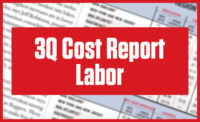For many contractors in 2022, concrete availability and pricing have been serious pressure points, and observers have varying opinions on whether this could continue into 2023. Prices for concrete products were up 14.3% for the 12 months between November 2021-22, according to the producer price index from the U.S. Bureau of Labor Statistics. Prestressed concrete products saw the highest spike, at 32.1% during that same period.
Those price hikes come as many contractors are seeing significant concrete shortages. Ken Simonson, chief economist at Associated General Contractors of America, says AGC has heard worries among contractors about availability of concrete products.
Part of the concern, Simonson says, is that the supply of concrete materials in the United States is limited, while imports have been slow to move. “Concrete is the material that I’m most worried about for 2023 in terms of availability,” he says. “Pricing may not be as extreme, but I also don’t expect any significant relief on prices.”
In the Midwest, barge traffic on the Mississippi—a major shipping route for concrete products in the region—was down 20% from the 10-year average, according to the U.S. Army Corps of Engineers. The Corps cites low water levels due to drought conditions as the major reason for the decline. Across all commodities, 11.7 million tons were transported on the Mississippi this year, down from roughly 13 million tons last year.
Michael Bruskin, vice president and chief procurement officer at Turner Construction, says that while the company has seen some fluctuations in pricing of concrete products nationally, concerns about shortages are mostly regional. Much of the East Coast, as well as Alabama, Mississippi and Louisiana, have seen shortages. Isolated shortages have also been reported in Ohio, Nevada and California. “Pricing doesn’t seem to be consistent with a supply chain that is clearly stretched, so we’re not sure what to make of it,” he says.
Fred Grubbe, president & CEO of the National Precast Concrete Association, acknowledges that companies continue to face supply chain issues in some parts of the U.S.. Imports have also been a serious issue. Grubbe says precast companies saw strong demand through 2021 and 2022. While that could continue into 2023, his members see the potential for a downturn on the horizon. “We’ve had three successive years of making money and doing very well as an industry,” he says. “We’re hearing from our members that the first two quarters of 2023 are looking pretty strong because they have contracts for projects that are going to commence in the first quarter and the second quarter of 2023. It’s the third quarter where things start to look a little more spotty.”
“Concrete is the material that I’m most worried about for 2023 in terms of availability.”
Ken Simonson, chief economist, Associated General Contractors of America
Ed Sullivan, chief economist at the Portland Cement Association, agrees that a downturn may lie ahead. Sullivan says that after a strong 2021 that saw 5% growth, he estimates that the industry stayed relatively stable with growth of around 1% this year. Sullivan adds that with high demand that continued through the winter, many companies had difficulty building sufficient inventories. That was compounded by freight issues and struggles with foreign imports. For example, Turkey is a major importer for materials, but those shipments have been hampered by the war in Ukraine, he says.
Sullivan sees market contraction in 2023. He notes that 80% of the growth in 2021 came from the residential market, which stayed strong through 2022. Going into 2023, given the combination of interest rate hikes and inflation, he forecasts a dip in residential. As a result, he estimates that the cement market could pull back by 3.5% in 2023, which would be the first decline in 14 years. That weakness is more likely to be seen in the second half of the year, he adds.
In terms of availability, Sullivan says “no one really knows how long the market tightness” will continue. “We do know it’s likely that demand [next year] will be less than it was this year. That should free up some inventories. Secondly, we fully expect imports will be at a very strong rate next year. In terms of that dynamic, there’s a greater likelihood that if this market tightness doesn’t disappear, it will at least lessen.”
.jpg?1640194190)

.jpg?height=200&t=1640194228&width=200)

.jpg?height=200&t=1640294268&width=200)